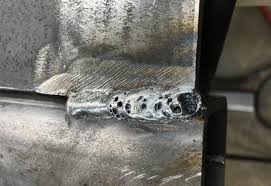Specialist Suggestions on What is Porosity in Welding and Just How to Resolve It
Unraveling the Enigma of Porosity in Welding: Tips for Lessening Defects and Maximizing Quality
In the complex globe of welding, porosity stays a persistent challenge that can dramatically influence the quality and honesty of welded joints. Comprehending the aspects that add to porosity formation is crucial in the pursuit of flawless welds. By unwinding the enigma of porosity and implementing efficient approaches for flaw reduction, welders can elevate the standards of their job to attain superior quality results. As we look into the midsts of porosity in welding, uncovering the secrets to its prevention and control will certainly be paramount for experts looking for to understand the art of high-quality weldments.
Comprehending Porosity in Welding
Porosity in welding, a typical problem come across by welders, describes the presence of gas pockets or voids in the bonded material, which can jeopardize the integrity and quality of the weld. These gas pockets are generally trapped throughout the welding procedure due to various variables such as inappropriate protecting gas, infected base products, or wrong welding specifications. The development of porosity can damage the weld, making it prone to breaking and corrosion, inevitably causing structural failures.
Recognizing the origin of porosity is vital for welders to successfully prevent its occurrence. By identifying the relevance of maintaining correct gas shielding, ensuring the tidiness of base materials, and maximizing welding settings, welders can dramatically minimize the possibility of porosity development. Furthermore, making use of techniques like pre-heating the base material, using appropriate welding strategies, and carrying out comprehensive examinations post-welding can even more assist in reducing porosity issues. In general, a comprehensive understanding of porosity in welding is crucial for welders to produce top notch and long lasting welds.

Usual Root Causes Of Porosity
When checking welding procedures for prospective high quality problems, comprehending the typical causes of porosity is important for preserving weld integrity and stopping architectural failings. Porosity, identified by the existence of tooth cavities or spaces in the weld metal, can considerably compromise the mechanical residential or commercial properties of a welded joint.
In addition, welding at improper criteria, such as exceedingly high travel rates or currents, can produce extreme disturbance in the weld pool, capturing gases and causing porosity. By resolving these common reasons through proper gas securing, material prep work, and adherence to optimal welding specifications, welders can minimize porosity and improve the top quality of their welds.
Methods for Porosity Avoidance
Executing reliable preventive actions is essential in lessening the occurrence of porosity Get the facts in welding procedures. One technique for porosity avoidance is guaranteeing proper cleansing of the base steel prior to welding. Impurities such as oil, grease, rust, and paint can lead to porosity, so complete cleansing using suitable solvents or mechanical approaches is important.

Making use of high-quality filler materials and shielding gases that are appropriate for the base metal and welding process can considerably decrease the threat of porosity. Additionally, maintaining correct welding specifications, such as voltage, present, travel speed, and gas circulation rate, is crucial for porosity avoidance.
Moreover, utilizing proper welding techniques, such his response as keeping a consistent traveling rate, electrode angle, and arc size, can aid protect against porosity (What is Porosity). Adequate training of welders to ensure they follow best practices and quality assurance treatments is likewise crucial in decreasing porosity flaws in welding

Finest Practices for Top Quality Welds
One secret technique is preserving correct sanitation in the welding location. Completely cleaning the workpiece and bordering area before welding can assist mitigate these concerns.
An additional ideal method is to carefully select the suitable welding parameters for the specific materials being signed up with. Correct criterion option makes sure More about the author optimum weld infiltration, blend, and total quality. Utilizing top notch welding consumables, such as electrodes and filler metals, can considerably impact the final weld top quality.
Relevance of Porosity Control
Porosity control plays a vital function in making certain the honesty and quality of welding joints. Porosity, characterized by the visibility of tooth cavities or gaps within the weld metal, can substantially compromise the mechanical properties and structural honesty of the weld. Extreme porosity damages the weld, making it extra prone to breaking, deterioration, and general failure under operational lots.
Effective porosity control is crucial for maintaining the preferred mechanical residential or commercial properties, such as strength, ductility, and durability, of the welded joint. What is Porosity. By lessening porosity, welders can boost the overall high quality and reliability of the weld, making sure that it fulfills the performance needs of the intended application
Moreover, porosity control is important for achieving the wanted visual look of the weld. Excessive porosity not only weakens the weld yet additionally takes away from its visual charm, which can be crucial in sectors where appearances are very important. Appropriate porosity control strategies, such as making use of the correct protecting gas, regulating the welding parameters, and guaranteeing appropriate tidiness of the base materials, are necessary for generating top quality welds with very little problems.

Verdict
In verdict, porosity in welding is an usual flaw that can jeopardize the high quality of the weld. It is vital to regulate porosity in welding to guarantee the stability and strength of the final item.